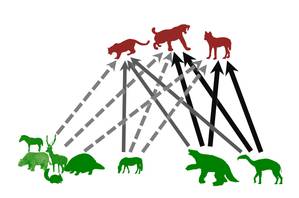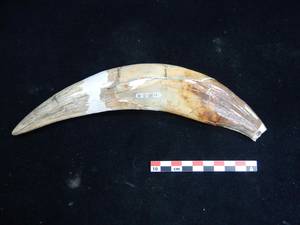News
17.03.2016
Saber-toothed cats hunted on the South American plains
University of Tübingen researchers refute theory that saber-tooths were forest dwellers
Like the lion which today lives in the African savannah, the saber-tooth “tiger,” Smilodon populator, inhabited the open, dry country found in South America during the ice age, according to Professor Hervé Bocherens of the Senckenberg Center for Human Evolution and Palaeoenvironment at the University of Tübingen. The results of his latest study have been published in the latest edition of the journal Palaeogeography, Palaeoclimatology, Palaeoecology. To find out more about the eating habits of what was then South America’s biggest cat, Bocherens and his team examined the bones of saber-toothed cats which lived in Argentina’s Pampas region in the period 25,000-10,000 B.C.
“Up to now, palaeontologists assumed that a predator weighing up to 400 kilograms and with bone structure similar to that of a forest-dwelling cat would have hunted in woodlands,” says Hervé Bocherens. It was thought that would make it easier for the animals – with their canines up to 30 centimeters long – to find hiding places from which to attack their prey. But Bocherens’ study points to a different conclusion. He compared collagen samples from the bones of various ice age predators – including the saber-toothed cat, the jaguar (Panthera onca), and a species of wild dog (Protocyon) – with those of their likely prey. The carbon and nitrogen isotopes he found there enable him to draw conclusions about the kind of environment the animals lived in.
The saber-toothed cats did not eat animals which were at home in thickly wooded country. Their chief prey seems to have been a camel-like, steppe-dwelling ungulate known to scientists as Macrauchenia, and two species of giant sloth (Megatherium und Lestodon) - who, unlike their surviving relatives, lived on the ground and could grow to several tonnes in weight. There could be a further parallel with today’s African lions; the bones of several individual saber-toothed tigers were found together and contained similar isotopes, Bocherens says – “It may be that these predators, too, hunted together in groups.”
The saber-toothed cat (Smilodon) evolved in North America and spread to South America with the formation of a stable land bridge between the two continents some three million years ago. It appears that the saber-toothed tigers’ fiercest competitors were not other big cats. The study indicates that the jaguar preferred smaller prey, such as rodents and species of horse. But the ice age dog (Protocyon) seems to have shared the saber-tooths’ culinary tastes.
Many types of megafauna died out at the end of the ice age, including the saber-toothed cat. Researchers debate the possible influence of climate change and human activity on the extinctions. The Tübingen researchers believe that a damper climate could have led to increased forestation of the steppe - reducing the saber-toothed tigers’ hunting grounds and ultimately causing them to die out.
The study received €170,000 of funding from the German Research Foundation.
Publication:
H. Bocherens, M. Cotte, R. Bonini, D. Scian, P. Straccia, L. Soibelzon, F. J. Prevosti: Paleobiology of sabretooth cat Smilodon populator in the Pampean Region (Buenos Aires Province, Argentina) around the Last Glacial Maximum: Insights from carbon and nitrogen stable isotopes in bone collagen, Paleogeography, Paleoclimatology, Paleoecology
<link http: dx.doi.org j.palaeo.2016.02.017>
dx.doi.org/10.1016/j.palaeo.2016.02.017
Contact:
Professor Hervé Bocherens
University of Tübingen
Senckenberg Center for Human Evolution and Palaeoenvironment (HEP)
Faculty of Science
Working group Biogeology
Phone +49 7071 29-76988
herve.bocherens[at]uni-tuebingen.de
 |  |
The prey (green) of ice age predators (red) Graphic: Bocherens/ University of Tübingen |
|
